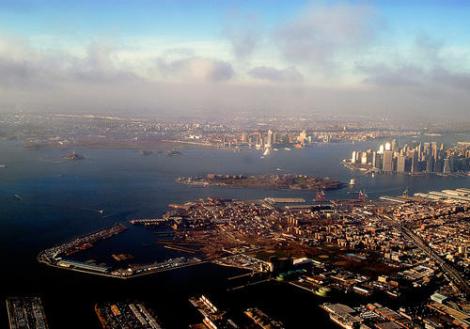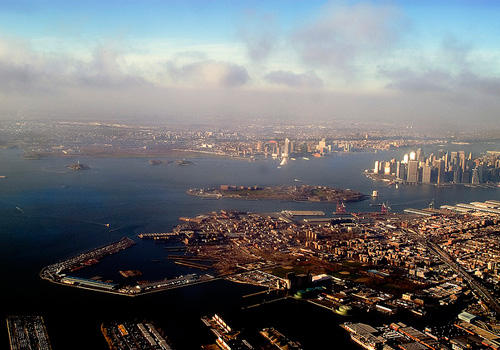Several weeks ago, we looked at what New York (and its lesser companion, Boston) is doing to prepare for higher tides, storm surges, and severe weather. But is it enough? Is New York City ready for climate change?

New York Harbor. Manhattan is at far right.
Critics, as they are wont to do, say no. From page A1 of today’s New York Times:
Only a year ago, they point out, the city shut down the subway system and ordered the evacuation of 370,000 people as Hurricane Irene barreled up the Atlantic coast. Ultimately, the hurricane weakened to a tropical storm and spared the city, but it exposed how New York is years away from — and billions of dollars short of — armoring itself.
“They lack a sense of urgency about this,” said Douglas Hill, an engineer with the Storm Surge Research Group at Stony Brook University, on Long Island.
The primary threat is flooding.
Unlike New Orleans, New York City is above sea level. Yet the city is second only to New Orleans in the number of people living less than four feet above high tide — nearly 200,000 New Yorkers, according to the research group Climate Central.
The waters on the city’s doorstep have been rising roughly an inch a decade over the last century as oceans have warmed and expanded. But according to scientists advising the city, that rate is accelerating, because of environmental factors, and levels could rise two feet higher than today’s by midcentury. More frequent flooding is expected to become an uncomfortable reality.
With higher seas, a common storm could prove as damaging as the rare big storm or hurricane is today, scientists say. Were sea levels to rise four feet by the 2080s, for example, 34 percent of the city’s streets could lie in the flood-risk zone, compared with just 11 percent now, a 2011 study commissioned by the state said.
Despite that risk, development directly adjacent to the shore continues, for an obvious reason: it’s valuable. This forces developers (and their political allies) into conflict with a city looking ahead to disaster.
Planning experts say it is hard to muster public support for projects with uncertain or distant benefits.
“There’s a lot of concern about angering developers,” said Ben Chou, a water-policy analyst at the Natural Resources Defense Council.
New York planners have proposed requiring developers to assess the climate-change risks faced by new buildings so they can consider protection like retractable watertight gates for windows. But no such requirements have been imposed so far.
It’s impossible not to read into the significance of telling this story on this day, the 11th anniversary of the attacks on the World Trade Center. When coupled with one of the paper’s most broadly shared stories today — how President Bush failed to heed warnings about the attack — the message from the Times is hardly subtle: We cannot afford to let disaster happen again.




